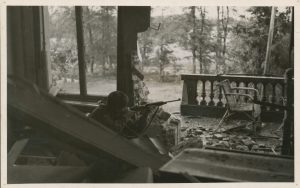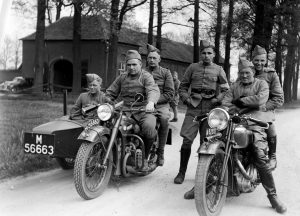 War in Arcadia, 1940-1945. Dutch country houses in the Second World War
War in Arcadia, 1940-1945. Dutch country houses in the Second World War
Dutch research project ends with two publications on history and heritage
In 2021 heritage organisation Gelders Genootschap and the Dutch Castle Foundation started a national research project on Dutch castles, country houses and estates in World War II: War in Arcadia, 1940-1945. The picturesque landscape, created by noblemen, regents and other country house owners, was viewed as Arcadia, as Paradise on earth. But from May 1940 to the liberation in 1945 this picturesque landscape, this Arcadia, was the background of the Second World War. For the Netherlands at least, little is known about the impact for country houses and their owners. In what way were ‘arcadian’ landscapes and country houses affected by the war? Were country houses confiscated, and to what purposes? In this research project we have looked at the history (what happened then?) and the heritage (how do we deal with it now?) of War in Arcadia. For three and a half years we researched Dutch castles and country estates in the Second World War. We have searched through countless archives, newspapers and image banks, spoken to (descendants of) eyewitnesses and done field work in places where the war is still almost palpable in the landscape. Just as important was the dialogue with current owners, researchers, estate managers and governments during the War in Arcadia excursions and network meetings about WWII heritage at country houses.
Read more below:
Historic research
Studying country estates as microcosms during occupation time provides a deeper understanding of rural life. Castles and country houses proved to be of great interest for both occupying and liberating military troops as it concerned large buildings in extensive landscapes, with good infrastructure and valuable resources (as arable land and forests) close by. As such, country houses and estate landscapes played a remarkable role during the course of World War II. To get a national overview we created databases with information on confiscation, damage, destruction, collaboration, resistance, refugees and looting at hundreds of Dutch country houses and estates.
In order to understand what the influence of the war was on the ‘arcadian’ world, we analysed the families and country houses that made up this world between 1900 and 1940. There was a great diversity in families, including the Royal family, nobility, patriciate and newly wealthy like industrialists and bankers, and possessions (from palaces to small country homes). In the pre-war decades, this world ranged from grandeur to decay.
Tensions about a possible war had been palpable in the Netherlands for some time. Some families decided to flee, such as British and Jewish estate owners and the Royal family. The Dutch government had prepared for a possible invasion by stationing soldiers throughout the country: more than 90 castles and estates were used by the Dutch military during this mobilisation period. The German invasion started on May 10 1940, followed by the Dutch capitulation five days later – after the bombing of the city of Rotterdam. During the occupation by Nazi Germany, more than 400 country houses and estates were requisitioned by the occupying forces. The military importance of ‘arcadia’ was studied, including the use as military headquarters and the construction of airfields, bombing installations and defence lines like the Atlantikwall along the coast. But the country houses and estates were also used as work camps, prisons, hospitals and schools. The evacuation of the coastal area, due to the construction of the Atlantikwall, furthermore resulted in the move of institutions to country houses (for instances, private schools, archives, museums and orphanages).
The period of occupation and the war during the liberation left deep marks in Arcadia: in the landscape, but also in the people. The battle caused damage and sometimes destruction of the built and landscape heritage. About 105 castles and country houses were completely destroyed by war and hundreds were slightly to severely damaged. How people decided to rebuild after the war (or decided to leave the castle ruins desolate in the landscape) was also studied, including the way one dealt with war remnants like anti-tank moats, bunkers and trenches. We have deliberately chosen to cover a wide range of themes; not only the military importance of estates is discussed, but also, for example, self-sufficiency, art (theft), the role of owners, tourism, destruction and reconstruction, remembrance and commemoration. We look at the lives of civilians and soldiers who sometimes had to live together for years. In doing so, this research presents images that are not simply black and white or right versus wrong. Of course, during the research we came across estate residents who were exceptionally heroic or very clearly Deutschfreundlich, but above all we came across many families who were trying to survive in this tense situation. On many advanced estates, not only the German occupier was present, but also people in hiding such as Jewish refugees, men who tried to avoid the Arbeitseinsatz and Allied soldiers.
This national, historical research used an interdisciplinary approach with substantive attention to the impact that the war had on buildings, residents, the landscape and the community around it. The study was based on a great diversity of sources, telling the national history of Dutch country houses in WWII, while at the same time paying attention to the local stories of daily life, using family archives and oral history. The historic research is published in the book Oorlog in Arcadië, 1940-1945. Nederlandse kastelen en landgoederen in de Tweede Wereldoorlog (published by WBooks, in Dutch). The book is edited by Elyze Storms-Smeets and Nick van den Berg, and has contributions of Marlieke Damstra, Julia van Duijvenvoorde, Wouter van Elburg, Merel Haverman, Manuela Hoepman, Ingrid Jacobs, Yme Kuiper, Ad van Liempt, Willemieke Ottens, Hinke Piersma, Michiel Purmer, Kees Ribbens, Hanneke Ronnes, Joost Rosendaal, Kim van de Ven, Fred Vogelzang, Sazya Zeefat and the editors. We are searching for funds to publish an English version.
Heritage research
We have also looked at traces of the war that are still present today and how the stories associated with this history can be told and shared. Together with current owners, governments and local historical societies, we have discussed the tangible and intangible war heritage of country houses and estates. The main question was: How do we, as owners, heritage institutions and governments, deal with the WWII past at country houses and estates, and how can we deal with this (better) in the future (concerning heritage tourism, education, representation, – policy and management)? We have selected four heritage regions spread across the Netherlands for the heritage research. Regions with a significant number of estates and where the war played a major role. The regions are Utrechtse Heuvelrug, North of Limburg, the Veluwezoom (Gelders Arcadia), and The Coast of North- and South-Holland (Atlantikwall).
In line with the Faro Convention, we placed our heritage community central. From the start, we organised all kinds of meetings with owners, governments and heritage institutions. To share knowledge and experience with each other, to increase support and awareness about the role that country houses played during the occupation; to reflect on commemoration and memory, to work together on ways to identify, accommodate, strengthen and develop (knowledge about) the intangible and material heritage of War in Arcadia; and to jointly establish and expand a strong community of practice. Together with our community of estate owners, managers, governments, heritage institutions and other stakeholders, we have worked on various products and activities:
- Heritage documentaries for each region (short films of c. 30 minutes each)
- Study visits and war heritage meetings
- Inventory of war heritage per region
- Publication: Guidelines on dealing with war heritage on estates (tangible and intangible)
The Guidelines on WWII heritage is an online publication. Together with our community we chose four main themes:
- Collections and Research: Knowledge about WWII history and traces on an estate forms the basis for management and policy. A wide range of professional and amateur researchers are researching various aspects of WWII history and heritage at estates, including: archaeologists, art historians, geographers, military historians and conservators. What sources do you use for WWII research? How do you deal with sources that contradict each other? Also interesting are the collections of WWII heritage within archives and museums.
- Management and Policy: Estate owners and governments often find it difficult how to deal with WWII heritage at estates. This concerns both the tangible heritage (bunkers, trenches, etc.) and the intangible heritage (the stories and meanings). How do you create policy on war heritage and how do you anchor it? What does the presence of physical war heritage mean for estate management?
- Remembrance and Commemoration: The British saying ‘Lest we forget’ expresses the desire to keep the memory strong of what happened during the war and those who died during the war. The Second World War is still very much alive in many people’s minds. Remembering, commemorating and telling stories is an important part of WWII heritage. Which stories do we know and pass on? How do we tell those stories, and how do we deal with multi-perspectiveness? How do we ensure that we don’t tell a one-sided story, but that there is diversity? How do we remember and commemorate?
- The Power of Design: Design plays an important role in dealing with contemporary war heritage (architecture, landscape architecture, art and design). How do you design buildings and landscapes that tell a strong WWII story or in which deep traces of this history remain? How can a bunker (e.g. Clingendael) or sports hall (e.g. Avegoor) built by the German occupier be repurposed while reflecting on its conflicted history and looking ahead together? To what extent does this relatively short period in the long estate history determine contemporary design choices? How can contemporary art contribute to telling war stories?
The guidelines include inspiring examples from home and abroad about how people have dealt with the WWII past at country houses and estates. The concluding chapter ‘Voices from the Present’ contains about thirty interviews with members of our community of practice: researchers, curators, administrators, volunteers, (descendants of) estate owners, governments and podcast makers. With this guide we offer readers concrete recommendations and inspiration, which will hopefully help with heritage tourism, education, representation, policy and management of WWII heritage on castles, country estates and estates. For more information, please contact project manager dr. Elyze Storms-Smeets: e.storms@geldersgenootschap.nl

